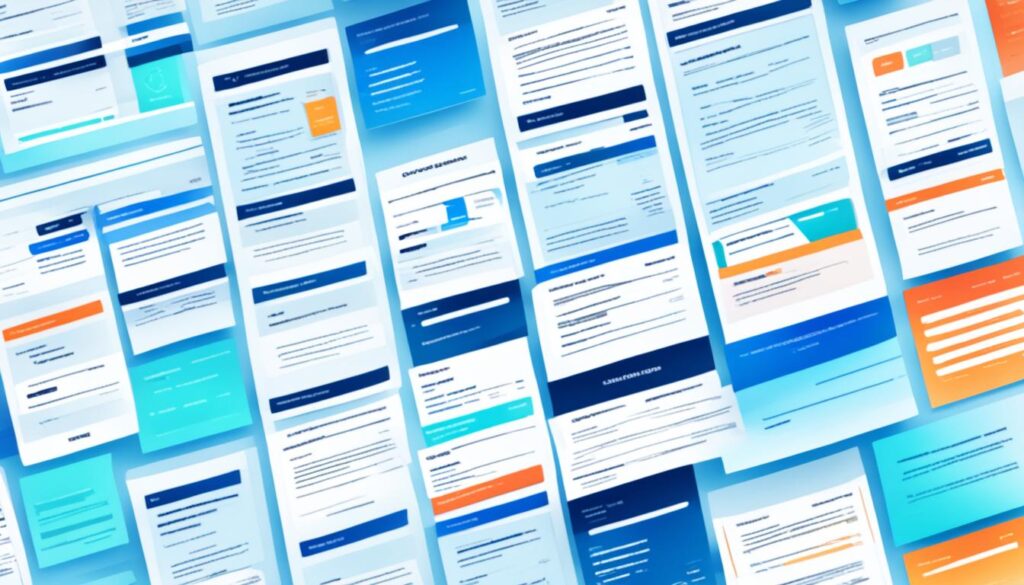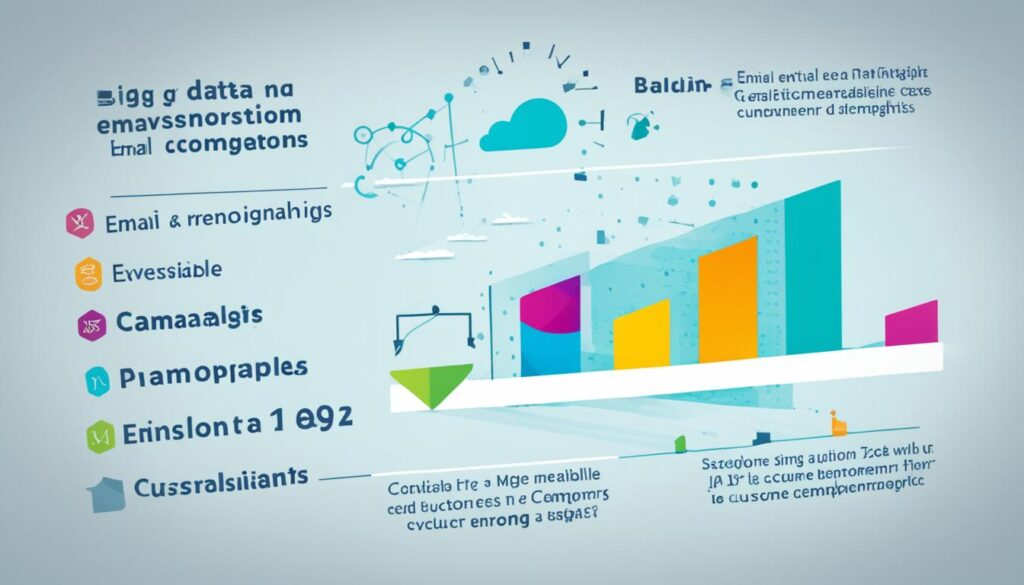With the ever-increasing volume of data being collected and analyzed, big data is revolutionizing email marketing. This powerful tool is transforming the way businesses approach their email campaigns, allowing for more personalized and effective strategies.
Email analytics is at the forefront of this evolution. By leveraging big data, marketers can gain valuable insights into their audience’s behavior, preferences, and engagement patterns. This data-driven approach enables businesses to optimize their marketing strategies and deliver tailored content that resonates with their subscribers.
In this article, we will explore the impact of big data on email marketing and how it is reshaping the way businesses connect with their customers. From personalized email campaigns to data-driven marketing strategies, we will uncover the benefits of harnessing the power of big data in email marketing.
Key Takeaways:
- Big data is transforming email marketing by providing valuable insights into customer behavior.
- By leveraging email analytics, businesses can optimize their campaigns and deliver personalized content to their subscribers.
- Data-driven marketing strategies enable businesses to make informed decisions and drive better results.
- Personalized email campaigns based on big data analysis lead to higher customer engagement and conversion rates.
- Embracing big data in email marketing is essential for businesses to stay competitive and succeed in the digital age.
The Power of Big Data in Email Marketing
Big data provides email marketers with powerful tools and insights to improve their campaigns. By leveraging email automation tools, marketers can streamline their processes and send targeted messages based on customer actions. This automation saves time and effort while ensuring that the right message reaches the right audience at the right time.
Predictive analytics in email marketing is another game-changer. With the help of advanced algorithms and machine learning, businesses can now predict customer behavior and optimize their campaigns accordingly. By analyzing data such as previous purchase history, browsing patterns, and demographic information, marketers can gain valuable insights that enable them to create highly personalized and engaging email content.
“Using predictive analytics in email marketing allows businesses to send the right message to the right person, increasing the chances of conversion and customer satisfaction.” – Marketing Expert
Real-time data analysis is vital for monitoring and tracking the performance of email campaigns. By analyzing real-time data, marketers can make immediate adjustments to their email content, subject lines, or send times to optimize results. This data-driven approach ensures that campaigns are continuously improving, resulting in higher open rates, click-through rates, and conversions.
In summary, the power of big data in email marketing lies in its ability to provide email automation tools, predictive analytics, and real-time data analysis. Marketers can leverage these tools and insights to send targeted messages, predict customer behavior, and optimize campaign performance for better results.
Benefits of Big Data in Email Marketing:
- Increased efficiency and productivity with email automation tools
- Highly personalized and targeted email campaigns based on predictive analytics
- Real-time tracking and adjustments for improved campaign performance
| Email Marketing Advantage | Big Data Benefits |
|---|---|
| Email Automation Tools | Saves time and effort by streamlining processes |
| Predictive Analytics | Improves targeting and engagement by predicting customer behavior |
| Real-time Data Analysis | Enables immediate adjustments for better campaign performance |

Personalization and Targeting with Big Data
Big data has opened up new possibilities for email marketers to personalize and target their campaigns like never before. By harnessing the power of data, businesses can optimize email performance and deliver more relevant content to their subscribers. Let’s explore some of the big data trends in email marketing that are shaping the future of this industry.
Audience Segmentation Based on Patterns
One of the key benefits of big data in email marketing is the ability to segment audiences based on patterns. By analyzing customer data, marketers can identify common characteristics or behaviors and group subscribers accordingly. This allows for more targeted and tailored email campaigns, ensuring that each recipient receives content that aligns with their interests and preferences.
“Audience segmentation based on patterns enables email marketers to send highly targeted campaigns, resulting in better engagement and improved conversion rates.”
Improving Targeting and Engagement
With big data, email marketers have access to a wealth of information about their subscribers. By utilizing this data, marketers can gain insights into customer preferences, past purchases, and browsing behaviors. This allows for better targeting and engagement, as marketers can tailor their content to individual recipients based on their specific interests and needs.
“Big data enables email marketers to deliver personalized experiences that resonate with subscribers, leading to increased engagement and ultimately, higher conversions.”
Leveraging Customer Data for Personalized Campaigns
Big data allows marketers to leverage customer data to create highly personalized campaigns. By analyzing customer behavior and preferences, marketers can create targeted content that speaks directly to each individual subscriber. Whether it’s incorporating their name in the subject line or offering tailored product recommendations, personalized campaigns are more likely to capture the attention of recipients and drive desired actions.
To optimize email performance with big data, email marketers should focus on leveraging customer data, segmenting audiences based on patterns, and delivering personalized experiences that resonate with subscribers. By embracing these big data trends in email marketing, businesses can take their campaigns to the next level and achieve greater success in engaging and converting their audience.

Leveraging Transactional Emails
Transactional emails play a crucial role in email marketing, serving as vital touchpoints for businesses to communicate with their customers. These emails, such as order confirmations, shipping notifications, or account updates, provide an excellent opportunity for leveraging big data to optimize email marketing campaigns.
By analyzing customer data and behavior, businesses can use big data to send targeted and relevant content in transactional emails. This personalized approach enhances the customer experience and increases open and click-through rates. Incorporating big data analytics into transactional emails allows businesses to deliver more impactful messages, driving customer engagement and ultimately fostering long-term customer relationships.
Enhancing Customer Experience with Relevant Content
Transactional emails offer a unique chance to connect with customers at critical moments in their journey. By leveraging big data, businesses can tailor the content of these emails to meet each customer’s specific needs and preferences.
“Using big data analytics, we can identify patterns and trends in customer behavior, allowing us to provide highly relevant content in our transactional emails. We’ve seen a significant increase in customer engagement as a result.”
For example, a customer who recently made a purchase can receive personalized recommendations based on their previous buying behavior. By leveraging data on the customer’s purchase history, browsing habits, and preferences, businesses can create targeted offers and product suggestions specifically tailored to that individual. This level of personalization significantly increases the chances of the customer making another purchase, thus driving revenue and customer loyalty.
Optimizing Triggered Emails with Big Data Insights
In addition to transactional emails, triggered emails based on customer actions or specific events can also be optimized using big data insights. These emails are activated when a customer takes a particular action, such as abandoning a shopping cart or subscribing to a newsletter.
By utilizing big data analytics, businesses can analyze customer behavior and triggers to deliver timely and relevant communications. For instance, a customer who has abandoned a cart can receive a triggered email with a personalized discount or an exclusive offer, specifically designed to bring them back to complete the purchase.
As Christina Davis, Email Marketing Manager at XYZ Company, explains:
“With big data, we can track customer behaviors in real-time and create triggered email campaigns that align closely with their interests. This not only increases conversions but also helps build stronger customer relationships.”
The ability to segment and analyze customer data empowers businesses to send the right message to the right person at the right time. Leveraging big data allows marketers to create highly relevant and impactful triggered emails, driving customer engagement, and maximizing conversion rates.

Incorporating big data analytics into transactional and triggered emails unlocks immense potential for businesses to enhance their email marketing efforts. By leveraging customer insights and behavior patterns, businesses can deliver personalized and targeted content, ultimately driving customer engagement, loyalty, and long-term success.
Harnessing the Power of Big Data
To fully leverage the potential of big data in email marketing, businesses must undertake ambitious big data projects. These projects involve defining the problem at hand, preparing the necessary components, and launching into action. The first step is understanding the power of data-driven decision making. Marketers need to dive into the depths of data analysis, identify emerging trends, and make informed decisions that enhance their email campaigns. Ultimately, data analysis plays a crucial role in comprehending customer behavior and optimizing email marketing efforts.
The process of harnessing big data begins by defining the problem that needs to be addressed. By clearly identifying the specific challenge or opportunity, businesses can ensure that their big data projects remain focused and purposeful. For example, a company might want to improve open rates for their email campaigns or tailor their content more effectively towards individual customer preferences.
“Big data projects in email marketing involve defining the problem, preparing the necessary components, and launching into action.”
Preparing the Necessary Components
Once the problem is defined, businesses need to gather the necessary components for their big data projects. This involves data collection from various sources, including customer behavior data, demographic data, and transactional data. Tools such as email automation software and analytics platforms are invaluable for capturing and organizing this information effectively.
In addition to data collection, businesses also need to ensure they have the necessary infrastructure in place to handle the volume and complexity of big data. This may involve scaling up their data storage capabilities, investing in powerful analytical tools, or partnering with skilled data analysts who can extract meaningful insights.
Launching Into Action
With the problem defined and the necessary components in place, businesses can now launch into action. This involves implementing data-driven strategies and making data analysis a key part of the decision-making process. Marketers should regularly analyze email campaign data to identify trends, patterns, and areas for improvement.
Data-driven decision making in email marketing requires continuous monitoring and analysis. By tracking key performance indicators (KPIs) such as open rates, click-through rates, and conversion rates, marketers can gain a deeper understanding of what is working and what needs refinement. This iterative process allows businesses to optimize their email campaigns over time and drive better results.
Ultimately, harnessing the power of big data in email marketing requires a strategic approach and a commitment to data-driven decision making. By embarking on big data projects, businesses can unlock valuable insights into customer behavior and optimize their email campaigns for maximum impact.
Future Trends and Considerations
The future of email marketing is an exciting one, with big data and emerging trends opening up new possibilities for businesses. One of the key trends in the industry is the integration of artificial intelligence (AI) into email marketing strategies. AI has the capability to analyze vast datasets and provide valuable insights that can revolutionize the way marketers engage with their audience.
By harnessing the power of AI, businesses can optimize their email campaigns in real-time. AI algorithms can analyze customer behavior and preferences, allowing marketers to personalize content for individual subscribers. This level of personalization enhances the customer experience, leading to increased engagement and better campaign performance.
Consider this hypothetical scenario: A customer receives an abandoned cart email, and instead of a generic message, the email is tailored to showcase products similar to what the customer had added to their cart. This level of personalization based on AI analysis can significantly increase the chances of conversion.
However, with the integration of AI and big data, marketers should also be mindful of privacy and security concerns. As data collection and utilization continue to evolve, it is important to prioritize customer privacy and ensure that data is handled ethically and securely. Marketers must establish transparent data policies and comply with relevant regulations to build trust and maintain customer loyalty.
To stay ahead in the rapidly changing digital marketing landscape, marketers need to stay informed and adaptable. Keeping a pulse on emerging trends in email marketing and understanding the potential of AI will be crucial. By continuously learning and evolving their strategies, marketers can effectively leverage big data and AI to drive better results and create compelling email campaigns.

Summary:
| Key Takeaways |
|---|
| Integration of artificial intelligence (AI) in email marketing |
| Real-time optimization of email campaigns using AI |
| Personalization of email content based on AI analysis |
| Privacy and security concerns in data collection and utilization |
| Importance of staying informed and adaptable in the digital marketing landscape |
Conclusion
Big data has revolutionized email marketing, providing businesses with the tools and insights to optimize their campaigns and deliver personalized experiences to their customers. By leveraging data-driven marketing strategies, businesses can create more targeted and effective email campaigns, resulting in higher engagement and improved ROI.
The benefits of using big data in email marketing are immense. With the ability to analyze vast amounts of customer data, businesses can gain valuable insights into customer behavior and preferences. This allows marketers to make informed decisions, tailor their email content, and improve the overall customer experience.
As technology continues to advance and consumer behavior evolves, embracing big data in email marketing will be essential for success in the digital age. By harnessing the power of big data, businesses can stay ahead of their competitors, drive better results, and build stronger relationships with their customers.
FAQ
How is big data revolutionizing email marketing?
Big data is revolutionizing email marketing by providing powerful tools and insights to optimize campaigns, deliver personalized experiences, and improve customer engagement.
How can email automation tools help in email marketing?
Email automation tools streamline processes and enable marketers to send targeted messages based on customer actions, improving campaign efficiency and effectiveness.
What is the role of predictive analytics in email marketing?
Predictive analytics allows businesses to predict customer behavior and optimize email campaigns accordingly, increasing the chances of delivering relevant content and achieving better results.
How does real-time data analysis impact email campaigns?
Real-time data analysis helps marketers track the performance of their email campaigns, make adjustments in real-time, and optimize for better results.
How does big data optimize email performance?
Big data allows businesses to understand customer preferences and behaviors, enabling them to optimize email performance by delivering more relevant content to subscribers.
What are some big data trends in email marketing?
Big data trends in email marketing include audience segmentation based on patterns, improving targeting and engagement, and leveraging customer data to create highly personalized campaigns.
How can businesses leverage transactional emails?
By analyzing customer data and behavior, businesses can send targeted and relevant content in transactional emails, leading to higher open and click-through rates, and ultimately improving customer engagement.
How can triggered emails be optimized using big data?
Triggered emails, based on customer actions or specific events, can be optimized using big data to increase conversions and drive customer engagement by delivering timely and personalized messages.
What is the process of harnessing the power of big data in email marketing?
To harness the power of big data, businesses need to embark on big data projects, define the problem, prepare the necessary components, analyze data, identify trends, and make informed decisions to improve their email campaigns.
What are some future trends in email marketing with big data?
Emerging trends include the integration of artificial intelligence (AI) to analyze vast datasets, optimize email campaigns in real-time, and personalize content for individual subscribers.
What are some considerations when using big data in email marketing?
Marketers should consider privacy and security concerns as data collection and utilization continue to evolve. Staying informed and adaptable will be crucial to success in the rapidly changing digital marketing landscape.








